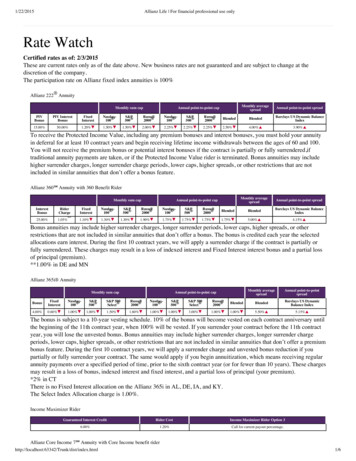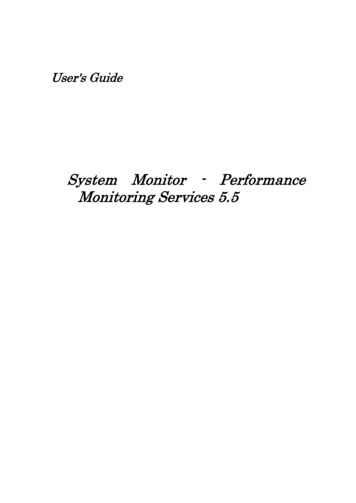
Transcription
Going beyond simple infrastructuremonitoring with HP SiteScopeWhite paper
Table of contentsExecutive overview . . . . . . . . . . . . . . . . . . . . . . . . . . . . . . . . . . . . . . . . . . . . . . . . . . . . . . . . . . . . . 3Going agentless . . . . . . . . . . . . . . . . . . . . . . . . . . . . . . . . . . . . . . . . . . . . . . . . . . . . . . . . . . . . . . . 3Available HP SiteScope monitors . . . . . . . . . . . . . . . . . . . . . . . . . . . . . . . . . . . . . . . . . . . . . . . . . . . 4SNMP by MIB monitor . . . . . . . . . . . . . . . . . . . . . . . . . . . . . . . . . . . . . . . . . . . . . . . . . . . . . . . . . 4Network bandwidth monitor . . . . . . . . . . . . . . . . . . . . . . . . . . . . . . . . . . . . . . . . . . . . . . . . . . . . . 5Script monitors . . . . . . . . . . . . . . . . . . . . . . . . . . . . . . . . . . . . . . . . . . . . . . . . . . . . . . . . . . . . . . 5Enterprise application monitors . . . . . . . . . . . . . . . . . . . . . . . . . . . . . . . . . . . . . . . . . . . . . . . . . . . 7Get started quickly with solution templates. 7Consolidate and extend your monitoring. . . . . . . . . . . . . . . . . . . . . . . . . . . . . . . . . . . . . . . . . . . . . . 8HP SiteScope and HP System Availability Management software . . . . . . . . . . . . . . . . . . . . . . . . . . . . 8HP SiteScope and HP Operations Center . . . . . . . . . . . . . . . . . . . . . . . . . . . . . . . . . . . . . . . . . . . . 8HP SiteScope and HP Software-as-a-Service (SaaS) . . . . . . . . . . . . . . . . . . . . . . . . . . . . . . . . . . . . . 8For more information . . . . . . . . . . . . . . . . . . . . . . . . . . . . . . . . . . . . . . . . . . . . . . . . . . . . . . . . . . . 9Appendix: HP SiteScope supported monitors . . . . . . . . . . . . . . . . . . . . . . . . . . . . . . . . . . . . . . . . . . . 9System monitors . . . . . . . . . . . . . . . . . . . . . . . . . . . . . . . . . . . . . . . . . . . . . . . . . . . . . . . . . . . . . . 9Application monitors. . . . . . . . . . . . . . . . . . . . . . . . . . . . . . . . . . . . . . . . . . . . . . . . . . . . . . . . . 11Web/URL monitors . . . . . . . . . . . . . . . . . . . . . . . . . . . . . . . . . . . . . . . . . . . . . . . . . . . . . . . . . . . 11Network service monitors . . . . . . . . . . . . . . . . . . . . . . . . . . . . . . . . . . . . . . . . . . . . . . . . . . . . . . . 12
Executive overviewHP SiteScope software provides a wealth of functionality beyond simple systems monitoring. This paperwill showcase many advanced capabilities of HPSiteScope software that can enable an enterprise tomonitor more of its infrastructure, including SimpleNetwork Management Protocol (SNMP) by management information bases (MIB), network bandwidth,script and enterprise application monitors. The paperwill also review HP SiteScope solution templates—collections of standard and solution-specific monitorsthat consist of default metrics, default thresholds andproactive tests. The paper will conclude with information on several ways HP SiteScope can be complementedthrough the use of other HP products.You can leverage HP SiteScope software in manyways, including expanding the range of devices andapplications that can be monitored, managing serviceavailability, and checking network health in real time.This white paper will help you understand how toextend your use of HP SiteScope beyond simplesystems monitoring by learning how to: Use HP SiteScope SNMP by MIB to monitor a multitude of various devices in the enterprise. Monitor network devices and bandwidth. Become a power user by using the “Swiss ArmyKnife” of HP SiteScope—the script monitor. Deploy HP SiteScope solution templates for specificthird-party applications or infrastructure software,including Microsoft Exchange, Oracle Database,leading application servers and many more.Going agentless “Move up the stack” and monitor applications throughthe HP SiteScope MQ series, SAP and Siebel monitors.HP SiteScope software is well known for its industrypioneering agentless monitoring capabilities. Thousandsof companies have implemented HP SiteScope formonitoring hardware and operating systems across theIT enterprise, reaping huge benefits in reducing thetotal cost of ownership (TCO) for enterprise management. Combine other offerings from HP to enhance systemavailability management and incorporate the enduser experience.HP SiteScope agentless monitoring is complementary toagent-based solutions. By combining both, IT organizations can achieve balance of depth and completenessof coverage.Less known is the fact that HP SiteScope offers a wealthof powerful functionality beyond simple systems monitoring. HP estimates that the average HP SiteScopeuser is currently only taking advantage of a small setof the product’s features and benefits. Most customersare very familiar with HP SiteScope for CPU and URLmonitoring, but the product offers a veritable gold mineof additional features and functionality that can greatlyenhance the enterprise’s monitoring capabilities.HP SiteScope provides the ability to monitor availabilityand performance across your enterprise’s entire ITinfrastructure. It includes more than 75 standardmonitor types that cover most mainstream hardware,operating systems, applications, application components and networking equipment.The diversity of monitor types available in HPSiteScope offers you the ability to monitor not just abroad range of systems, but also systems at multiplelevels. This allows you to monitor the availability of aweb page, whether or not the web server is droppingtoo many requests, if required services are running onthe server machine, whether proper ports are open,if the hard drive is full or not, and whether or not theserver CPU is overloaded.3
Available HP SiteScopemonitorsHP SiteScope offers monitors in the following categories: System monitors: Provide everything necessary forbasic system monitoring and system management,including coverage for operating system and hardware metrics. Application monitors: Provide monitoring for all typesof applications throughout a distributed enterprise,including web servers, application servers, middleware, enterprise resource planning (ERP) and customerrelationship management (CRM) applications. Web/URL monitors: Use specifically for monitoringwebsite performance or web-related processes,including web services. Network service monitors: Use for monitoringnetwork services and network-related processes oroperations.Some of the HP SiteScope monitors that are currently available include:Network servicesDHCPDNSFormula compositeFTPMailMAPINetwork bandwidthPingPortRTSPSNMPSNMP by MIBSNMP trapWindows dial upWeb transactionE-business transactionLink checkURLURL contentURL listURL sequenceWeb scriptGenericCompositeDirectoryFileJMXLog fileScriptWeb serviceXML metricsStreamReal Media PlayerReal Media ServerWindows Media PlayerWindows Media ServerApplicationApache serverASP serverBroadVision application serverCheck PointCisco WorksCitrixColdFusion serverCOM serverDynamoF5IIS serveriPlanet serverNewsOracle 9i application serverOracle10gASRadiusSAP CCMSSAP CCMS alertSAP Java Web application serverSAP performanceSAP work processesSiebel application serverSiebel logSiebel web serverSilverStream serverSunONE web serverTuxedoUDDI serverVMware monitorWebLogic application serverWebSphere application serverWebSphere MQ statusWebSphere performance servletServerCPUDisk spaceIPMIMemoryServiceUNIX resourcesWeb serverWindows NT event logWindows NT performance counterWindows resourcesWindows services stateDatabaseDatabase counterDatabase queryDB2DB2 8.xLDAPOracle DatabaseSQL ServerSybaseIntegrationHP OVO EventHP ServiceCenterNetScout EventTechnology Database IntegrationTechnology Log File IntegrationTechnology SNMP Trap IntegrationTechnology Web Service IntegrationThe following sections will review some of HP SiteScope’smost powerful and flexible—yet sometimes littleknown—monitors.SNMP by MIB monitorHP SiteScope’s SNMP by MIB monitor is one of themost flexible monitors available. Because so much ITinfrastructure (and other equipment for that matter)has been instrumented via SNMP, HP SiteScope canliterally monitor just about anything. Via SNMP by MIBmonitoring, HP SiteScope can watch over anythinginstrumented via a MIB, including networking, mainframe, and even heating, ventilation and air conditioning (HVAC) devices. The SNMP by MIB monitorcollects and monitors SNMP data from any networkinfrastructure component, including routers andswitches. The type of data that can be provided bythese network infrastructure components can helpmonitor the health of the entire network.There are many potential applications for this technology. One HP customer is currently using SNMP by MIBto monitor the wind speed in a wind tunnel used forbuilding Formula One race cars. HP is even using HPSiteScope SNMP by MIB to monitor the company’sheating and cooling system at its Boulder, Coloradooffice.4
Figure 1. HP SiteScope network bandwidth monitor displays real-time information for quick identification of bandwidth availability.Bandwidth Metrics for 10.0.0.252(information from 9.29 AM 5/22/05 to 9:23 Am 5/23/05)Network bandwidth monitor Incoming discarded packetsThe HP SiteScope network bandwidth monitor is basedon the same technology as the SNMP by MIB monitor,but adds additional functionality focused on networkingdevices. The network bandwidth monitor can monitorany network device that utilizes an Interfaces GroupManagement Information Base (IF-MIB), which includesabout 90 percent of the routers, switches, load balancersand other devices on the market. By utilizing the network bandwidth monitor’s built-in ability to read IF-MIBvalues, companies can easily troubleshoot basic networking issues with HP SiteScope’s agentless technology. Outgoing discarded packetsThe network bandwidth monitor watches each port ofa networking device and has the capability to collectnumerous metrics per port, including: Bytes in Bytes out Packets in Packets out Incoming packets in error Outgoing packets in error Out queue length Percentage of bandwidth utilizationScript monitorsYou can extend HP SiteScope through the use of scripting. HP SiteScope script monitors verify script execution.Scripts are generally used to retrieve information that isnot readily available through other monitors. They alsoprovide a common and well-appreciated approach fortaking corrective action. The power of script monitorsis the ability to leverage the creativity of the monitoradministrator as they resolve difficult or multi-steprequirements. For an example of script monitors inaction, go to ime.html.5
Here is an example of a script monitor to restart Internet Information Server (IIS) service:‘* File: restartService.vbs‘* Created: Jan 2001‘* Version: 1.0‘*‘* Main Function: Restarts a service.‘*‘* Arguments server service ‘*‘* Example: To restart IIS on a server named “Server ”‘* cscript restartService My Server IIS‘*‘*‘*‘* Warning: This script make use of WMI api if you want to run‘* script on an NT 4 machine you need to install WMI Core‘* Software Installation for NT 4.‘* See **************set args Wscript.argumentsON ERROR RESUME NEXTdim strSever,strService,i‘Change these two lines fro the desired server and service‘Note: When calling this script from a SiteScope Script Alert arg 7 and arg 8 are the first two arguments pass to‘ the script from the Parameters filed on the “Define Script Alert” window.‘ Arg 7 Service‘ Arg 8 SeverstrService args (7)strServer args (8)Set ServiceSet GetObject (“winmgmts:{impesonationLevel impersonate}//” &strServer) .ExecQuery (“select * from Win32 Service where Description ’ ” & strService &” ‘ “)‘Note do not enable the WScript.Echo stamens when using this script with SiteScope.‘If you do the script will display a dialog window that SiteScope can not respond to and‘will cause the script to hang.i 0for each Service in ServiceSeti i 1RetVal Service.StopService()if RetVal 0 then‘WScript.Echo strService & “ Service stopped”elseif RetVal 5 then‘WScript.Echo strService & “ Service already stopped”end itRetVal Service.StartService()‘WScript.Echo strService & “ Service started”nextif i 0 then‘Wscript.Echo strService & “ Service not found”end ifOne of the “latest power user trends” HP has seen is the ability to execute WMI scripts. HP SiteScope has theability to utilize any of the hundreds of scripts provided by Microsoft or ones created by end users. The followingexample of a Windows Management Instrumentation (WMI) script (to retrieve the latest service pack) canprovide useful diagnostic information when resolving server issues:strComputer “.”Set objWMIService GetObject (“winmgmts:”& “(impersonationLevel impersonate}!\\” & strComputer & “\root\cimv2”)Set colOperatingSystems objWMIService.ExecQuery(“Select * from Win32 OperatingSystem”)For Each objOperatingSystem in colOpeatingSystemsWscript.Echo objOperatingSystem.ServicePackMajorVersion& “.” & objOperatingSystem.ServicePackMinorVersion6
Enterprise application monitorsMany customers may not know that HP SiteScope canmonitor most packaged applications (including enterprise applications) on the market today. HP SiteScopeoffers a wide array of monitors for all types of applications throughout a distributed enterprise including webservers, application servers, middleware, ERP, enterprise application integration (EAI) and CRM applications.HP SiteScope is able to monitor SAP, Siebel, OracleDatabases, BEA WebLogic and IBM WebSphere. Byconnecting to a supplied application program interface (API) (such as CCMS for SAP, JMX, or WebLogic)significant metrics are available that can reveal thehealth, availability and performance of the application.Get started quickly withsolution templates.One of the challenges in monitoring any infrastructureis knowing what about the infrastructure needs to bemonitored. With such a vast array of devices, applications and technologies, being an expert on the entireinfrastructure is a daunting—if not impossible—task.HP has recognized this fact and has created HPSiteScope solution templates in response.HP SiteScope solution templates are collections ofstandard and solution-specific monitors that consist ofdefault metrics, default thresholds and proactive tests.Each solution template also includes a best practicesguide that explains the rationale behind the defaultmetrics and thresholds, as well as a troubleshootingsection that explains the next steps to take in solvingperformance problems. These solution templates enableIT staff to rapidly deploy multi-tiered, performancemonitoring for the IT elements and applications supporting key business services—all without requiringIT administrators to be experts on the critical metricsfor each target to be monitored.Individual monitorsSolution templateDefault metricsSometimesAlwaysBuilt-in thresholdsRarelyAlwaysBest practices documentNoYesDeploymentDeploys a singlemonitorDeploys a “solutionset” of monitors allat onceSpecific troubleshootingmonitorsNoMost solutiontemplatesSolution templates provide simple yet comprehensivemonitoring without requiring users to be experts onthe application. Some of the key benefits of pre-builtsolution templates include: Reduce the need for specialized domain expertise. Reduce the time to configure and deploy monitors. Reduce wasting monitoring points on lower-prioritymetrics. Help to identify and speed troubleshooting of bothreal-time performance bottlenecks and longer-termtrends. Provide descriptions of all metrics, and in manycases, why the metrics are important. Provide “troubleshooting next steps” in a specializedbest practices guide.7
HP is constantly developing new HP SiteScope solutiontemplates. The following solution templates are currentlyavailable: Microsoft Exchange Server 5.5, 2000, 2003 Microsoft Active Directory BEA WebLogic Application Server IBM WebSphere Application Server Oracle Database Siebel Application, Gateway and Web Server SAP .NET Host/OS (Windows , Solaris , Linux, AIX)Consolidate andextend your monitoring.HP SiteScope can be expanded by using several different, complementary HP products and services, including:HP SiteScope and HP SystemAvailability Management softwareIt is common for mid-size to large deployments to makeuse of multiple HP SiteScope servers across the enterprise. For some of these deployments, it is desirable tocontrol all HP SiteScope instances through a commonmanagement console, as well as to consolidate databetween the various instances. HP System AvailabilityManagement software provides a common management console as well as consolidated data and reporting capabilities across multiple HP SiteScope instances.HP System Availability Management is part of the HPBusiness Availability Center product suite.HP System Availability Management software connectsto HP SiteScope (or existing Enterprise ManagementSystem (EMS) products) to collect and monitor systemavailability and performance data from across theentire enterprise using HP SiteScope as its data collection engine.By using HP System Availability Management and HPSiteScope together, companies not only obtain thebenefit of consolidating monitoring, but also gain astarting point with HP Business Availability Center software, which optimizes the availability, performance andeffectiveness of your business services and applications.HP SiteScope and HP OperationsCenter softwareThe majority of IT organizations use a combinationof agent-based and agentless monitoring. Each hasits advantages: Agent-based monitoring, such as HP OperationsCenter, provides the depth of monitoring to diagnosecomplex infrastructure problems in mission-criticalservers. Agentless monitoring, such as HP SiteScope, providesthe breadth of monitoring to allow fuller coverage ofyour IT infrastructure with lower management overhead and associated costs.By combining HP SiteScope and Operations Centersoftware, you have a balanced approach to infrastructure monitoring that achieves both the breadth and depthrequired.HP SiteScope andHP Software-as-a-Service (SaaS)Another way to expand HP SiteScope monitoring isby adding transaction-oriented, “outside-looking-in”monitoring to HP SiteScope systems and applicationmonitoring. HP SaaS for HP Business AvailabilityCenter provides customers with the ability to monitorthe end-user experience of a company’s externalfacing applications from over 80 locations on majorInternet service providers (ISPs) around the world.HP SaaS uses business process monitors to emulateend users accessing ERP, CRM or custom applications.This information provides insight into transaction performance by capturing statistics such as round-tripresponse time and transaction breakdowns. This hostedmonitoring capability complements HP SiteScope’sinternal view, thereby offering a complete picture ofperformance and aiding in problem resolution.Integration with HP SaaS is simple. HP SiteScope canbe configured to send its infrastructure performancedata to the HP SaaS central repository. This data canthen be combined with transaction performance data,offering a correlated view of the end-user experienceand the performance of related hardware and applications. Trend reports and service-level managementanalysis are also available.8
Figure 2. HP System Availability Management allows you to consolidate infrastructure management data from multiple HP SiteScopeand third-party systems.The HP SaaS team includes performance engineers,technical consultants, 24x7 support staff, systemadministrators, network administrators, databaseadministrators and HP Business Availability Centeradministrators. The team takes care of all installation,configuration and setup requirements, including procurement of all hardware, software and storage needed.HP SaaS also assigns a named technical accountmanager to work with the customer’s organization tounderstand unique business requirements and provideongoing mentoring.HP SaaS is a great way to take the next step from HPSiteScope to HP Business Availability Center withoutactually deploying HP Business Availability Center inthe IT environment. HP SaaS delivers hosted end-usermanagement, discovery and dependency mapping,service-level management and problem isolationapplications—plus ongoing expertise. This hostedapproach offers time to value in weeks or even days,reduces TCO, and can be transitioned to a full, inhouse implementation of HP Business AvailabilityCenter at any time.For more informationTo learn more about how to monitor more of whatmatters with HP SiteScope or to implement complementary solutions, contact your HP representative orvisit us online at www.hp.com/software.Appendix: HPSiteScope supportedmonitorsSystem monitorsThese monitors provide everything necessary for basicsystem monitoring and system management includingcoverage for operating system and hardware metrics.Composite monitorMonitor the status readings of multiple monitors ormultiple groups of monitors. Create alerts based uponmore than one status reading.CPU utilization monitorReport the percentage of CPU currently in use to verifythat you know if the CPU is being overloaded.Database monitorVerify database queries.DHCP monitorDetermine whether an IP address can be obtainedfrom a Dynamic Host Configuration Protocol (DHCP)server.Directory monitorMonitor file count and size within a directory.9
Disk space monitorReport the percentage of disk space currently in useso that you can act before you run out of disk space.File monitorMonitor file system parameters such as the size, ageand content of a file, and receive notification of anychanges.IPMI monitorMonitor hardware parameters such as temperature,voltage, fan speed, etc. on Intelligent PlatformManagement Interface (IPMI)-enabled servers.LDAP monitorVerify that an Lightweight Directory Access Protocol(LDAP) server is working correctly by connecting toit and performing a simple authentication. Optionally,it can check the result for expected content.Log file monitorGenerate warnings and errors based upon data in anapplication’s log file. For example, many applicationswrite error messages to a log file. This monitor canscan those log files, looking for error messages andgenerating alerts when it finds them.Memory monitorMeasure virtual memory usage and receive proactivenotification of problems.News monitorConnect to a Network News Transfer Protocol (NNTP)server and verify that groups can be retrieved.Network monitorTrack network statistics for your server. Informationprovided by the network monitor can help you trackdown performance problems related to networkinterfaces on your servers.NT dial-up monitorDial into an ISP or remote access server and confirmthat a connection can be made. Once connected, itcan execute user-defined commands and measureperformance.NT event log monitorWatch one of the Windows NT event logs (system,application or security) and trigger alerts when entriesare added.NT performance counter monitorRetrieve the value of any Windows NT performancecounter and send alert if this value is out of a specifiedrange.Radius monitorSend an authentication request to a radius server.Script monitorVerify script execution.Service monitorVerify that specified processes are running, includingweb, mail, File Transfer Protocol (FTP), news, gopher,Telnet and domain name server (DNS).Application monitorsThe following monitors provide monitoring for all typesof applications throughout a distributed enterpriseincluding web servers, application servers,middleware, ERP and CRM applications.Apache web serverMonitor Apache server statistics such as bytes persecond, requests per second and CPU load.ATG Dynamo application serverMonitor server statistics for ATG Dynamo applicationservers.10
BEA TuxedoMonitor BEA Tuxedo server availability.BEA WebLogic application serverMonitor server statistics for BEA WebLogic applicationservers.BroadVision application serverMonitor server statistics for BroadVision applicationservers.Netscape Enterprise/iPlanetMonitor key performance statistics for NetscapeEnterprise/iPlanet web servers.Novell SilverStreamMonitor SilverStream statistics such as current load,total sessions and average request process time.Oracle9i application serverMonitor server statistics for Oracle9i application servers.Check Point FireWall-1Monitor Check Point firewall parameters such asfwEvent, fwRejected and fwLogged.Oracle JDBCTest an Oracle database by connecting to it andperforming a query using JDBC.Cisco WorksMonitor Cisco Works server parameters.Real One/Real Media player and serverMonitor server statistics on RealNetworks streamingmedia players and servers.Citrix MetaFrameMonitor the Citrix MetaFrame server by measuringcounters such as session average, data bandwidthand session compression.COM Monitor performance metrics for COM applications.IBM DB2Monitor a DB2 database.IBM WebSphere application serverMonitor performance statistics for IBM WebSphereapplication servers including JVM, EJB, JSP and othercomponents.IBM WebSphere MQ serverMonitor the status of WebSphere MQ channels,queues and events.F5 Big-IP monitorMonitor F5 Big-IP load-balancing server parameters.SAP CCMSMonitor SAP performance metrics via SAP’s standardCCMS interface.SAP GUIMonitor the availability and performance statistics ofa SAP application server.Siebel server manager and Siebel web serverMonitor key components for Siebel servers and webservers.SunONE serverUse the latest Stats-XML performance metrics file todisplay counters for selection, including several derivedcounters that track utilization metrics.Sybase databaseMonitor Sybase database applications.Web/URL monitorsMacroMedia ColdFusion serverMonitor ColdFusion statistics such as page hits persecond, queued requests or average request time.These monitors are used specifically for monitoringwebsite performance or web-related processes includingweb services.MAPITest Microsoft Exchange server by sending a messagevia messaging application programming interface(MAPI).E-business chain monitorVerify that a complete chain of actions is completed asintended including front-end web servers, e-mail notifications, back-end databases and more.Application monitorsLink check monitorMonitor all internal and external website links for linkintegrity.Monitor performance for most Microsoft applicationsincluding: Active Directory ASP Exchange IIS SQL .NETURL monitorVerify availability and access time for specified URLs toverify that web pages are available within an acceptable time frame. On Windows NT, HP SiteScope takesadvantage of the platform’s integrated support tomonitor HTTPS URLs with advanced security featuresin addition to HTTP URLs. Windows Media Player and Server11
URL content monitorRetrieve a selected URL, checking for multiple stringsof text within the page.FTP monitorVerify that a file can be retrieved from a File TransferProtocol (FTP) server.URL list monitorMonitor an entire list of URLs, rather than definingseveral separate URL monitors.Mail monitorVerify that the mail server is accepting requests, andthat messages can be sent and retrieved.URL sequence monitorVerify a session that includes multiple pages. Anexample of this would be entering an account namevia a web form and checking an account status for thepage that is returned.Ping monitorVerify that specified hosts are available via the networkto provide nearly continuous availability of criticalconnections.Web server monitorReport data recorded by the web server log such ashits, bytes, errors, hits per minute and bytes per minute. Netscape Enterprise Netscape FastTrac Microsoft IIS O’Reilly websiteWeb service monitorSend SOAP requests to a web-service-enabledapplication to verify availability.Network service monitorsPort monitorDetermine whether a service on a port can beconnected to.Real streaming monitorMeasure the availability and quality of a real streamfrom a client-side perspective.Real Time Streaming Protocol (RTSP) monitorDetermine the availability of real-time media streams.Monitor real-time media streams.SNMP monitorUse industry-standard Simple Network ManagementProtocol (SNMP) to monitor network devices.SNMP trap monitorThe following monitors are used for monitoring networkSearch through SNMP traps for specific values. Togetherservices and network-related processes/operations.with HP SiteScope’s native SNMP listener, this monitorlets HP SiteScope act as an SNMP managementDNS monitorVerify that the domain name server (DNS) is accepting console.requests. Verify that the address for a specific domainname can be found.Formula (bandwidth) compositeCreate a measurement based on an arithmetic calculation of the results from two other monitors.To learn more, visit www.hp.com/software Copyright 2008 Hewlett-Packard Development Company, L.P. The information contained herein is subject to changewithout notice. The only warranties for HP products and services are set forth in the express warranty statements accompanying such products and services. Nothing herein should be construed as constituting an additional warranty. HP shallnot be liable for technical or editorial errors or omissions contained herein. Microsoft, Windows NT and Windows areU.S. registered trademarks of Microsoft Corporation. Oracle is a registered U.S. trademark of Oracle Corporation,Redwood City, California. Linux is a U.S. registered trademark of Linus Torvalds. Solaris and Java are U.S. trademarksof Sun Microsystems, Inc. UNIX is a registered trademark of The Open Group.4AA1-8052ENW, April 2008Technology for better business outcomes
Title: Blank grid.qxd Created Date: 4/17/2008 3:45:19 PM











